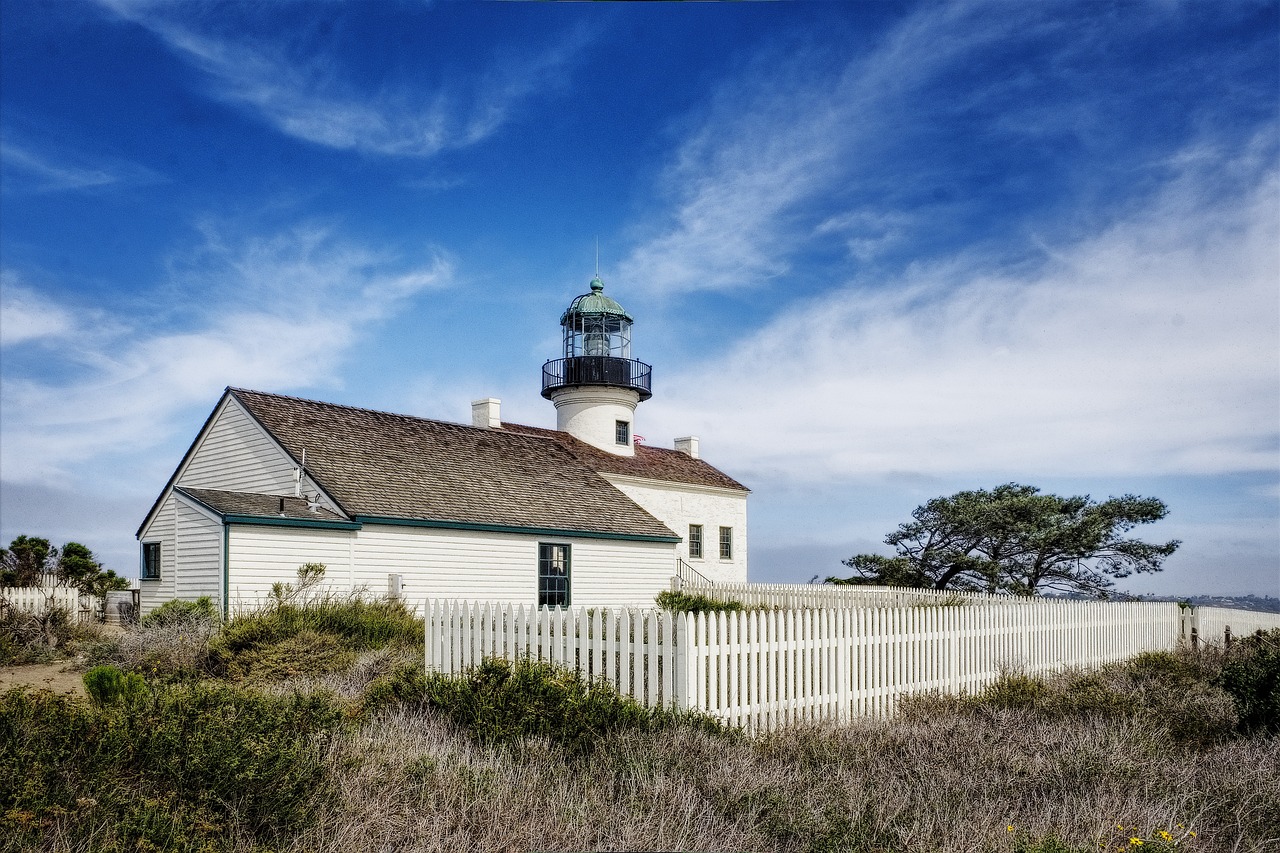Introduction
Maine’s rugged and rocky coastline, characterized by its picturesque bays, craggy cliffs, and endless waves, has long been both a navigational challenge and a source of inspiration. Along this storied shoreline, the state’s lighthouses stand as iconic sentinels, guiding mariners safely through treacherous waters and capturing the hearts of residents and visitors alike. In this article, we embark on a journey to explore the enchanting world of Maine’s lighthouses, uncovering their rich history, significance, and enduring charm.
Maine’s rugged coastline, with its dramatic scenery, has always presented a unique blend of beauty and peril. The juxtaposition of craggy cliffs and picturesque bays, pounded relentlessly by the Atlantic’s endless waves, creates a landscape of stark contrasts. This challenging terrain has been both a testament to nature’s raw power and a call to human ingenuity.
Navigational Challenges: The Need for Beacons
For centuries, this unforgiving coastline posed a significant navigational challenge for mariners. Treacherous rocks, hidden shoals, and shifting sandbars made navigation perilous, especially in the era of wooden sailing ships. Mariners relied on their skills, local knowledge, and rudimentary charts to navigate these treacherous waters.
Lighthouses as Beacons of Hope
It was against this backdrop of danger that Maine’s lighthouses emerged as beacons of hope. Each lighthouse, perched strategically along the coastline, possessed a unique light signature—its own “fingerprint” of light and darkness, sometimes with distinctive colors or patterns. These signatures allowed sailors to identify their location and steer clear of danger.
A Rich Tapestry of History
The history of Maine’s lighthouses is a rich tapestry woven with tales of keepers’ dedication, heroism, and sacrifice. Keepers were often isolated, spending long stretches of time tending to the lights and maintaining the structures. They braved harsh weather, sometimes living in cramped quarters with their families.
These keepers often became local legends, celebrated for their unwavering commitment to keeping the lights burning. The stories of keepers like Abbie Burgess, who single-handedly tended the Matinicus Rock Light during a brutal winter storm, became enduring symbols of Maine’s maritime heritage.
Preserving Heritage and Natural Beauty
Today, Maine’s lighthouses serve not only as navigational aids but also as guardians of the state’s natural beauty. Many are located in or near protected areas, safeguarding fragile ecosystems, pristine islands, and unique wildlife habitats. These beacons not only guide ships but also serve as a reminder of the need to preserve and protect the natural wonders that surround them.
Enduring Symbols of Maine’s Coastal Heritage
Maine’s lighthouses are more than just structures; they are enduring symbols of the state’s coastal heritage. They evoke a sense of nostalgia, conjuring images of an era when these lights were the only lifeline for sailors navigating through fog, storm, and darkness.
Today, Maine’s lighthouses continue to captivate the hearts of residents and visitors alike. They are open for tours, museums, and even overnight stays, allowing people to experience their timeless charm up close. As we explore the enchanting world of Maine’s lighthouses, we discover not only their rich history and navigational significance but also their enduring allure—a reminder of the indomitable spirit of Maine’s coastal communities and the enduring power of these iconic sentinels.
If you’d like to dive deeper into this subject, there’s more to discover on this page: Lana Del Rey – Mariners Apartment Complex Lyrics | Genius Lyrics
Maine’s coastline stretches over 3,000 miles, dotted with numerous islands, inlets, and hidden hazards. As early as the late 18th century, mariners recognized the need for navigational aids along this perilous shoreline. Lighthouses began to emerge as beacons of safety and hope, guiding ships away from danger and guiding them home.
Maine’s coastline stretches over 3,000 miles, a rugged expanse of natural beauty that simultaneously hides treacherous obstacles and offers breathtaking vistas. From the earliest days of maritime exploration in the late 18th century, seasoned mariners recognized the urgent need for navigational aids along this perilous shoreline.
Amidst the rocky crags, numerous islands, and unpredictable inlets, the idea of lighthouses began to emerge as beacons of safety and hope. These iconic structures, often perched atop dramatic cliffs or nestled on remote islands, became the guardians of the sea, tirelessly shining their guiding light into the darkness, steering ships away from danger, and helping sailors find their way home.
As the years passed, these lighthouses not only served as crucial navigational tools but also took on a romantic and symbolic significance. They became enduring symbols of resilience and guidance, offering solace to those facing the turbulent waters of life’s challenges. Lighthouse keepers, with their dedication and unwavering commitment to duty, became legends in their own right, their stories woven into the fabric of Maine’s coastal history.
Each lighthouse along Maine’s coastline tells a unique tale, standing as a testament to human ingenuity and the enduring partnership between humanity and the sea. From the iconic Portland Head Light to the remote and picturesque Bass Harbor Head Light, these structures are a living testament to Maine’s maritime heritage.
Today, as tourists and adventurers explore Maine’s rugged shores, they can’t help but be captivated by the timeless beauty and historical significance of these lighthouses. They serve as a reminder that even in the most challenging and unpredictable environments, human innovation can provide a steady light to guide the way, and that hope and safety are never too far from reach, thanks to the enduring legacy of Maine’s coastal beacons.
Additionally, you can find further information on this topic by visiting this page: Find a SkillBridge Opportunity – DOD SkillBridge Program

Maine’s lighthouses are architectural marvels that blend seamlessly with their natural surroundings. Many are constructed of locally quarried granite, a testament to Maine’s rugged beauty. Iconic structures like Portland Head Light, commissioned by George Washington in 1791, showcase timeless beauty and resilience in the face of harsh coastal elements.
Each lighthouse possesses its unique characteristics and history. West Quoddy Head Light, for instance, stands proudly as the easternmost lighthouse in the United States, guiding ships away from the treacherous Quoddy Narrows.
nullExplore this link for a more extensive examination of the topic: The BEST Maine Wheelchair accessible 2023 – FREE Cancellation …

The history of Maine’s lighthouses is intertwined with maritime legends and stories. The keepers who manned these beacons faced isolation, harsh weather, and personal sacrifices to ensure the lights shone brightly. Their dedication and heroism are celebrated in tales passed down through generations.
One such legend is the story of Joshua James, keeper of the Damariscove Island Light. James is remembered for his bravery and countless rescues, saving sailors in distress along the Maine coast. His legacy lives on as a symbol of selflessness and heroism.
The history of Maine’s lighthouses is a tapestry woven with maritime legends and stories, each beacon standing as a sentinel of the state’s rich nautical heritage. Beyond their function as navigational aids, these lighthouses hold the echoes of keepers who dedicated their lives to their maintenance, facing isolation, brutal weather, and personal sacrifices to ensure the lights shone brightly on the perilous coast.
The keepers of Maine’s lighthouses were often unsung heroes, their remarkable dedication and heroism etching unforgettable stories into the annals of maritime history. Tales of their sacrifices, their vigilance, and their unwavering commitment have been passed down through generations, becoming an indelible part of Maine’s cultural legacy.
One such legendary figure is Joshua James, the celebrated keeper of the Damariscove Island Light. Joshua James is not merely a historical footnote but a symbol of selflessness and heroism that continues to inspire. His legacy is a testament to the extraordinary feats of lighthouse keepers along the Maine coast.
Joshua James’s story is one of bravery in the face of unforgiving seas and tumultuous weather. He was renowned for his countless daring rescues, saving sailors in distress along the treacherous Maine coastline. His unwavering commitment to the safety of others earned him a reputation as a guardian angel of the sea.
In the midst of fierce storms and raging tempests, Joshua James and his crew would launch their lifeboats into the turbulent waters, risking their own lives to rescue stranded mariners. These heroic efforts became legendary, and James himself became a beacon of hope for those facing the perils of the sea.
James’s legacy is not confined to the pages of history; it lives on in the hearts of those who admire his courage and selflessness. He serves as a reminder that ordinary individuals, when faced with extraordinary circumstances, can rise to become true heroes. His name continues to be invoked as a source of inspiration for generations to come, a shining example of the unwavering dedication that defined Maine’s lighthouse keepers.
The history of Maine’s lighthouses, with stories like that of Joshua James, is a testament to the enduring spirit of those who have safeguarded the state’s coastline. These tales of bravery and sacrifice remind us of the resilience and humanity that have shaped Maine’s maritime heritage and continue to illuminate the path for future generations.
Additionally, you can find further information on this topic by visiting this page: Coastal Maine – Samantha Brown’s Places to Love

Maine’s lighthouses not only serve as navigational aids but also help protect the state’s natural treasures. Lighthouses like Seguin Island Light, located on a pristine island teeming with wildlife, play a vital role in preserving these fragile ecosystems. Visitors to these lighthouses often experience the unique opportunity to witness diverse wildlife, from seabird colonies to seals basking on nearby rocks.
Maine’s lighthouses are not just historic beacons of navigation; they are also guardians of the state’s natural treasures. These iconic structures stand as silent sentinels along the rugged coastline, guiding mariners safely through treacherous waters while concurrently contributing to the conservation and protection of Maine’s pristine ecosystems. Among these coastal guardians, Seguin Island Light, perched on a remote island teeming with wildlife, exemplifies the dual role these lighthouses play in preserving the state’s fragile ecosystems.
Seguin Island Light, with its rich maritime history dating back to the 18th century, is not merely a symbol of Maine’s seafaring heritage; it’s also a key player in the conservation of the island’s unique environment. Located in a remote and relatively untouched part of the coast, Seguin Island is a sanctuary for diverse wildlife. The presence of the lighthouse ensures that this habitat remains undisturbed and protected.
The strategic location of Seguin Island Light, perched atop a windswept bluff, offers breathtaking panoramic views of the surrounding sea and coastline. Visitors who make the journey to the island often find themselves immersed in the sights and sounds of nature. The island’s rocky shores provide ideal roosting and nesting sites for seabird colonies, including Atlantic puffins, guillemots, and gulls. The cliffs echo with the cacophony of their calls, creating a symphony of life that fills the air.
One of the most enchanting experiences for visitors is the chance to observe seals basking on nearby rocks. As you approach the island, you may witness these graceful marine mammals lounging in the sun, occasionally slipping into the water with a playful splash. It’s a reminder of the delicate balance of life in this remote ecosystem and the importance of maintaining its integrity.
Beyond its role in wildlife conservation, Seguin Island Light serves as a living museum, offering insights into the rich history of lighthouse keeping. Visitors can explore the keeper’s house and the lighthouse tower, gaining a deeper understanding of the challenges and traditions associated with maritime navigation in Maine’s coastal waters.
In essence, Maine’s lighthouses, including Seguin Island Light, are not just guardians of the sea; they are champions of nature. They embody the state’s commitment to preserving its natural treasures, providing safe passage for mariners while also protecting the fragile ecosystems that thrive along its coast. Visiting these lighthouses is not just a journey through history; it’s a connection to the timeless wonders of the sea and a reminder of our responsibility to safeguard the beauty and biodiversity of Maine’s coast for generations to come.
Should you desire more in-depth information, it’s available for your perusal on this page: Sinking of US Cargo Vessel SS El Faro Atlantic Ocean, Northeast of …

While modern technology has lessened the navigational role of lighthouses, their enduring charms remain as strong as ever. Today, many lighthouses are open to the public, offering tours, museums, and opportunities to climb to the top for panoramic views of the coast. These lighthouses continue to captivate the hearts of visitors who are drawn to their romantic and historic allure.
While modern technology has undoubtedly lessened the navigational role of lighthouses, their enduring charm and significance remain as powerful as ever. These iconic beacons of light have transcended their original purpose to become cherished symbols of coastal heritage and maritime history. Today, many lighthouses stand as living monuments, welcoming visitors with open doors and opportunities to explore their rich past while reveling in breathtaking coastal views.
The transformation of lighthouses from functional structures to public attractions has opened up a world of possibilities for curious travelers and history enthusiasts. Lighthouse keepers, once solitary figures tending to the lantern’s flame, have been replaced by knowledgeable guides who share the stories of these maritime sentinels. Visitors can now embark on guided tours, delving into the fascinating history of each lighthouse, learning about the brave individuals who kept them operational, and gaining insights into the vital role these beacons played in guiding ships to safety.
Many lighthouses have also evolved into maritime museums, offering an immersive experience that showcases artifacts, photographs, and maritime relics. These museums not only celebrate the lighthouses’ rich histories but also provide a glimpse into the seafaring culture and maritime traditions that have shaped coastal communities for generations.
One of the most enchanting aspects of visiting a lighthouse is the opportunity to climb to the top. Ascending the spiraling stairs or narrow ladders within the tower is a journey back in time, offering a unique perspective on the lighthouse keeper’s daily life and the breathtaking coastal vistas that surround these structures. Standing at the lantern room’s pinnacle and gazing out at the endless expanse of the sea is an unforgettable experience, allowing visitors to appreciate the lighthouse’s role in safeguarding sailors against treacherous waters.
The enduring allure of lighthouses transcends their historical and practical significance. These structures possess a romantic aura that captivates the hearts of those who visit them. The stark beauty of a lighthouse silhouetted against a dramatic coastal backdrop, often shrouded in mist or bathed in the warm glow of the setting sun, evokes a sense of nostalgia and wonder. It’s no wonder that lighthouses have become popular destinations for weddings, proposals, and even art and photography enthusiasts seeking to capture their timeless beauty.
In a world driven by technology and automation, lighthouses stand as poignant reminders of a simpler era when human determination and ingenuity were essential for safeguarding sailors. Their transition into public attractions ensures that their stories will continue to be shared, their legacy preserved, and their enduring charm cherished by generations to come. The mystique of lighthouses, with their beacon of hope and symbol of resilience, continues to shine brightly, drawing travelers and dreamers alike to the shores where history and romance meet the sea.
Additionally, you can find further information on this topic by visiting this page: GRE Literature in English Complete Flashcards | Quizlet

Maine’s lighthouses are not merely structures of stone and metal; they are beacons of history, hope, and inspiration. Their enduring significance goes beyond maritime navigation, as they serve as cultural landmarks, storytellers of heroism, and guardians of the state’s natural beauty. As they continue to guide mariners and capture the hearts of all who encounter them, Maine’s lighthouses stand as enduring symbols of the state’s rich coastal heritage.
nullFor a comprehensive look at this subject, we invite you to read more on this dedicated page: AIDS TO NAVIGATION MANUAL – ADMINISTRATION
More links
If you’d like to dive deeper into this subject, there’s more to discover on this page: Patriotic Memories at the Lighthouse – Pathways of the Heart
